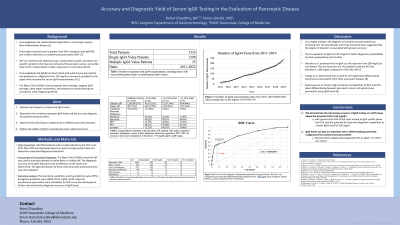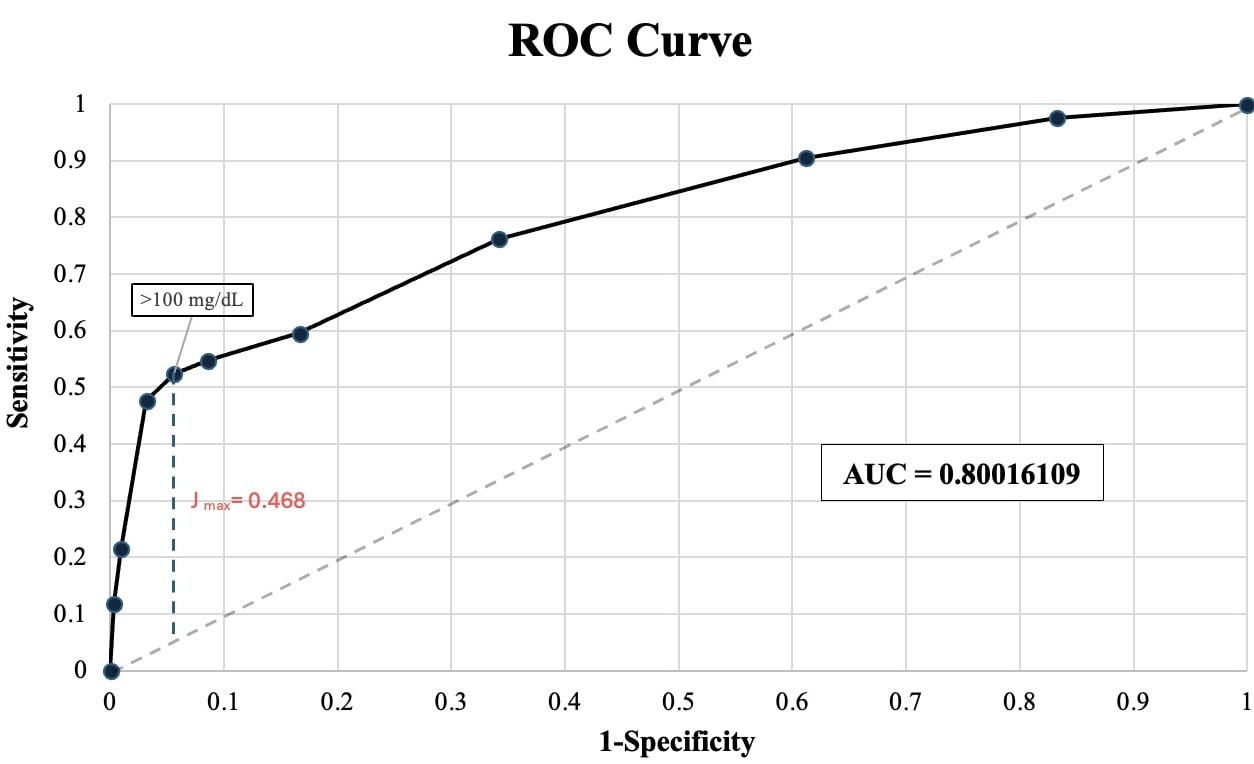Sunday Poster Session
Category: Biliary/Pancreas
P0012 - Accuracy and Diagnostic Yield of Serum IgG4 Testing in the Evaluation of Pancreatic Disease
Sunday, October 27, 2024
3:30 PM - 7:00 PM ET
Location: Exhibit Hall E

Has Audio
- RC
Rahul Chaudhry
SUNY Downstate Health Sciences University
Woodbury, NY
Presenting Author(s)
Rahul Chaudhry, 1, Tamas A.. Gonda, MD2
1SUNY Downstate Health Sciences University, Woodbury, NY; 2NYU Grossman School of Medicine, New York, NY
Introduction: Elevated IgG4 levels are known to be associated with autoimmune pancreatitis (AIP) and are often included in the work up for recurrent acute pancreatitis, chronic pancreatitis, and equivocal mass lesions. Our goal was to evaluate the accuracy and diagnostic yield of IgG4 levels at different cutoff ranges as obtained from patient measurements recorded during June 2011- May 2022.
Methods: We performed a comprehensive data search from the Electronic Health Record (EHR) to identify patients with an IgG4 laboratory test. Using Visual Basics, macros were developed to parse through patient data and determine diagnoses/indications for each IgG4 test. These included autoimmune pancreatitis, pancreatitis (other), mass/lesion, cyst/pseudocyst, pancreatic insufficiency, fatty pancreas, and calcification. Patients were further shortlisted by looking at their Epic EHR and determining their accordance with the Mayo Clinic HISORt criteria for AIP. Those who did not align with any criteria were characterized as “unlikely AIP,” and the diagnostic accuracy of the IgG4 laboratory test at different cut-off values was determined.
Results: A total of 1333 patients with IgG4 measurement were identified and testing increased more than thirteen-fold from 2011-2019. A relatively small number of results were above 2x and 3x ULN (1.5% and 0.6%, respectively). In Table 1 we demonstrate the diagnostic accuracy of IgG4 levels for AIP at different cutoff points. The data suggests consistently greater specificity than sensitivity, decreasing accuracy that becomes especially prominent at higher IgG4 cutoffs, and an ROC curve with an AUC of 0.8 and an ideal cut-off point of 100 mg/dL. Given the diagnostic implications, the frequency of abnormal IgG4 values in patients with a diagnosis of pancreatic malignancy was determined, and it was found that 5% had an IgG4 elevation 1-2x ULN and no patients had IgG4 levels >2x ULN.
Discussion: Use of IgG4 testing in the diagnosis of pancreatic diseases and it has previously been suggested that the degree of elevation is associated with greater accuracy. In a large single-center dataset over ten years, we conversely demonstrate the decreasing accuracy of IgG4 testing at cutoff values above the accepted ULN, with greater than 50% of AIP cases missed at IgG4 cutoffs above the ULN, and the potential for improved diagnostic capabilities at a lower IgG4 cutoff as per our ROC curve. Notably, there were no pancreatic malignancies diagnosed with an IgG4 > 2x ULN in our cohort.

Note: The table for this abstract can be viewed in the ePoster Gallery section of the ACG 2024 ePoster Site or in The American Journal of Gastroenterology's abstract supplement issue, both of which will be available starting October 27, 2024.
Disclosures:
Rahul Chaudhry, 1, Tamas A.. Gonda, MD2. P0012 - Accuracy and Diagnostic Yield of Serum IgG4 Testing in the Evaluation of Pancreatic Disease, ACG 2024 Annual Scientific Meeting Abstracts. Philadelphia, PA: American College of Gastroenterology.
1SUNY Downstate Health Sciences University, Woodbury, NY; 2NYU Grossman School of Medicine, New York, NY
Introduction: Elevated IgG4 levels are known to be associated with autoimmune pancreatitis (AIP) and are often included in the work up for recurrent acute pancreatitis, chronic pancreatitis, and equivocal mass lesions. Our goal was to evaluate the accuracy and diagnostic yield of IgG4 levels at different cutoff ranges as obtained from patient measurements recorded during June 2011- May 2022.
Methods: We performed a comprehensive data search from the Electronic Health Record (EHR) to identify patients with an IgG4 laboratory test. Using Visual Basics, macros were developed to parse through patient data and determine diagnoses/indications for each IgG4 test. These included autoimmune pancreatitis, pancreatitis (other), mass/lesion, cyst/pseudocyst, pancreatic insufficiency, fatty pancreas, and calcification. Patients were further shortlisted by looking at their Epic EHR and determining their accordance with the Mayo Clinic HISORt criteria for AIP. Those who did not align with any criteria were characterized as “unlikely AIP,” and the diagnostic accuracy of the IgG4 laboratory test at different cut-off values was determined.
Results: A total of 1333 patients with IgG4 measurement were identified and testing increased more than thirteen-fold from 2011-2019. A relatively small number of results were above 2x and 3x ULN (1.5% and 0.6%, respectively). In Table 1 we demonstrate the diagnostic accuracy of IgG4 levels for AIP at different cutoff points. The data suggests consistently greater specificity than sensitivity, decreasing accuracy that becomes especially prominent at higher IgG4 cutoffs, and an ROC curve with an AUC of 0.8 and an ideal cut-off point of 100 mg/dL. Given the diagnostic implications, the frequency of abnormal IgG4 values in patients with a diagnosis of pancreatic malignancy was determined, and it was found that 5% had an IgG4 elevation 1-2x ULN and no patients had IgG4 levels >2x ULN.
Discussion: Use of IgG4 testing in the diagnosis of pancreatic diseases and it has previously been suggested that the degree of elevation is associated with greater accuracy. In a large single-center dataset over ten years, we conversely demonstrate the decreasing accuracy of IgG4 testing at cutoff values above the accepted ULN, with greater than 50% of AIP cases missed at IgG4 cutoffs above the ULN, and the potential for improved diagnostic capabilities at a lower IgG4 cutoff as per our ROC curve. Notably, there were no pancreatic malignancies diagnosed with an IgG4 > 2x ULN in our cohort.

Figure: Image 1: ROC curve for the diagnosis of autoimmune pancreatitis using IgG4 levels. The AUC was calculated at 0.8 and the ideal IgG4 threshold was determined to be >100 mg/dL given its greater Youden Index (J) when compared to other cutoff points.
Note: The table for this abstract can be viewed in the ePoster Gallery section of the ACG 2024 ePoster Site or in The American Journal of Gastroenterology's abstract supplement issue, both of which will be available starting October 27, 2024.
Disclosures:
Rahul Chaudhry indicated no relevant financial relationships.
Tamas Gonda indicated no relevant financial relationships.
Rahul Chaudhry, 1, Tamas A.. Gonda, MD2. P0012 - Accuracy and Diagnostic Yield of Serum IgG4 Testing in the Evaluation of Pancreatic Disease, ACG 2024 Annual Scientific Meeting Abstracts. Philadelphia, PA: American College of Gastroenterology.
